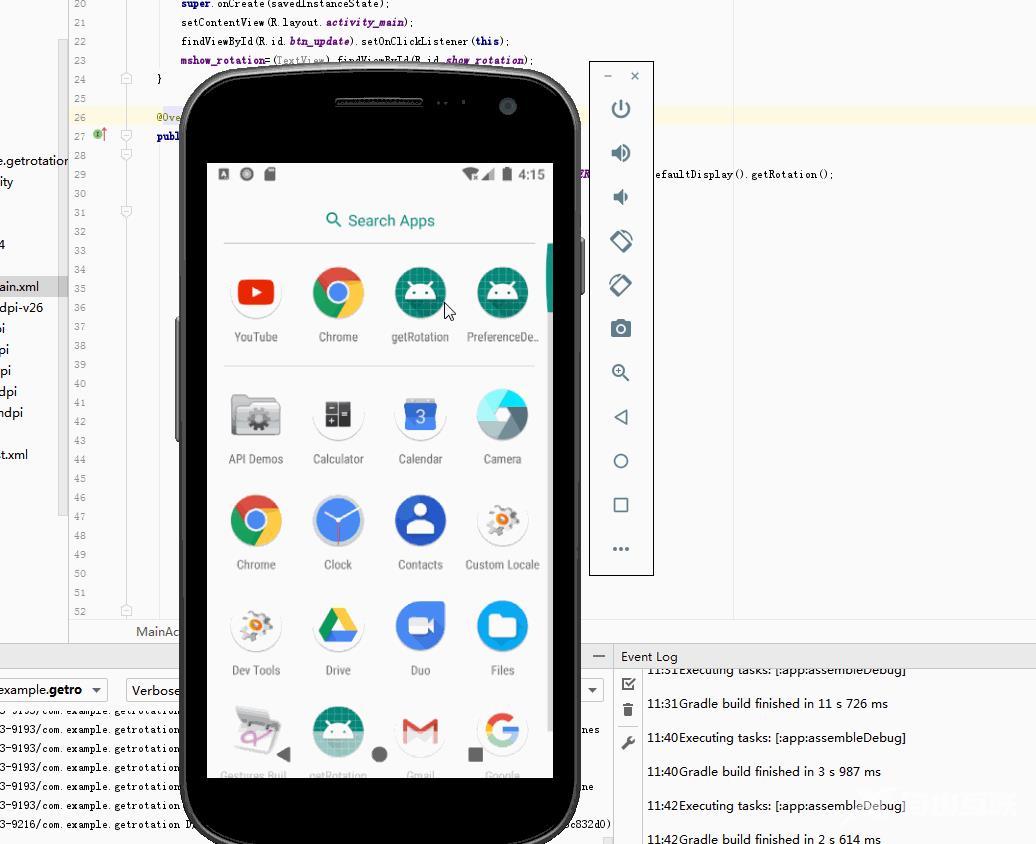本文实例为大家分享了Android App获取屏幕旋转角度的具体代码,供大家参考,具体内容如下 一、获取屏幕旋转角度的方法是 : int rotation = mActivity.getWindowManager().getDefaultDisplay().getRotati
本文实例为大家分享了Android App获取屏幕旋转角度的具体代码,供大家参考,具体内容如下
一、获取屏幕旋转角度的方法是:int rotation = mActivity.getWindowManager().getDefaultDisplay().getRotation();
二、测试代码
1、getRotation\app\src\main\java\com\example\getrotation\MainActivity.java
package com.example.getrotation;
import android.content.Context;
import android.content.Intent;
import android.support.v7.app.AppCompatActivity;
import android.os.Bundle;
import android.util.Log;
import android.view.Surface;
import android.view.View;
import android.view.WindowManager;
import android.widget.TextView;
import org.w3c.dom.Text;
public class MainActivity extends AppCompatActivity implements View.OnClickListener {
final String TAG="rotation";
TextView mshow_rotation;
@Override
protected void onCreate(Bundle savedInstanceState) {
super.onCreate(savedInstanceState);
setContentView(R.layout.activity_main);
findViewById(R.id.btn_update).setOnClickListener(this);
mshow_rotation=(TextView) findViewById(R.id.show_rotation);
}
@Override
public void onClick(View view) {
if (view.getId() == R.id.btn_update) {
int angle = ((WindowManager) getSystemService(Context.WINDOW_SERVICE)).getDefaultDisplay().getRotation();
switch (angle) {
case Surface.ROTATION_0:
Log.d(TAG, "Rotation_0");
mshow_rotation.setText(Integer.toString(0)+"℃");
break;
case Surface.ROTATION_90:
Log.d(TAG, "ROTATION_90");
mshow_rotation.setText(Integer.toString(90)+"℃");
break;
case Surface.ROTATION_180:
Log.d(TAG, "ROTATION_180");
mshow_rotation.setText(Integer.toString(180)+"℃");
break;
case Surface.ROTATION_270:
Log.d(TAG, "ROTATION_270");
mshow_rotation.setText(Integer.toString(270)+"℃");
break;
default:
Log.d(TAG, "Default Rotation!");
break;
}
}
}
}
2、布局文件activity_main.xml
<android.support.constraint.ConstraintLayout xmlns:android="http://schemas.android.com/apk/res/android" xmlns:app="http://schemas.android.com/apk/res-auto" xmlns:tools="http://schemas.android.com/tools" android:layout_width="match_parent" android:layout_height="match_parent" tools:context=".MainActivity"> <TextView android:id="@+id/show_rotation" android:layout_width="wrap_content" android:layout_height="wrap_content" android:text="" app:layout_constraintBottom_toBottomOf="parent" app:layout_constraintLeft_toLeftOf="parent" app:layout_constraintRight_toRightOf="parent" app:layout_constraintTop_toTopOf="parent" /> <Button android:id="@+id/btn_update" android:layout_width="wrap_content" android:layout_height="wrap_content" android:text="Get Rotation value" tools:layout_editor_absoluteX="145dp" tools:layout_editor_absoluteY="119dp" /> </android.support.constraint.ConstraintLayout>
三、执行效果

以上就是本文的全部内容,希望对大家的学习有所帮助,也希望大家多多支持自由互联。
